| |

|
|
Musical Milestone:
The Festival at Sandpoint:
25 years of melodies under the stars
The music is magic,
and so is something else:
the village that makes
it happen
Story by Cate Huisman
Photos by David Marx
It’s not the Music Festival, the Summer Festival, or even, officially, the Sandpoint Festival. On its program cover, it’s called the Festival at Sandpoint, but to locals it’s just “the festival.” In a town that celebrates winter, old boats, old cars, local fish, and numerous sports and arts in various guises, this is the festival that requires no further description. Everyone knows what it is.
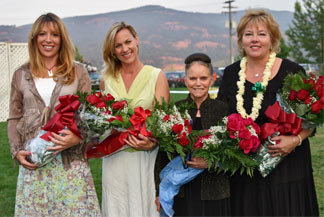
Festival Backbone: Toni Lund, Dyno Wahl,
Marcella Nelson and Carol Winget |
No wonder. “The community owns this event; I’m just a steward,” said the energetic Diana Wahl, known as Dyno, now entering her 10th season as executive director. And indeed, many residents have stories to tell about it and their encounters with its performers: when Keb’ Mo’ came to their garage sale, how they took the Doobie Brothers waterskiing, when they heard Natalie MacMaster play at the hospital, and what they did with the contents of a basket that a departing concertgoer accidentally left at the curb in front of their house. (After a futile effort to find the owner, they drank the wine, gave the sweaters and blankets to the Goodwill, and donated the money to the festival.)
But more important, the people have kept the festival alive through two decades of deficits and sometimes doubt. “It survives because this community wants it and has been willing over the course of 25 years to save it every time it floundered,” said Paula Parsons, a longtime board member and treasurer who served through some challenging times.
“It’s symbolic to me of what a small town can do,” said local resident and frequent audience member Michael Welp. “A lot of small towns wouldn’t dream of doing something like this. It speaks to the power of the community to not just pull it off but make it thrive.
”‘We’re too small a community to do what we do.’
–Paula Parsons, board member
This fruit of the community’s labor is housed for most of the year in the festival’s headquarters in The Old Power House downtown. Down a hallway lined with autographed photos of many of the artists who have played the festival are the offices of Wahl as well as Carol “Wingnut” Winget and Toni “Tone” Lund, the triumvirate of widely respected and oddly nicknamed women who start preparing for the festival each year in September, just after the previous festival has ended. The token male of the office group is a black lab named Porter, who has his own office chair into which he folds himself after greeting visitors.
The staff is rounded out by a part-time bookkeeper, Tamara Verby, and two other devoted part-timers who spend much of their spring and summer preparing for and working the festival: Dave Nygren, the production manager, and Mike “Rug” Ruskey, the stage manager, who got his moniker (shortened from “Rughead”) from a high school coach who wouldn’t let him play until he had a haircut.
Festival staff can’t say enough about the additional crew hired seasonally or about the 400 volunteers who keep coming back every summer. Some volunteers take their vacations to chair committees that they have run for years, and others come every night after working a full day at their real jobs. “They are unquestionably the heroes of this particular event,” said Ruskey.
Nor can they praise their fellow staff members highly enough. “Thanks, Wingnut and Tone, for 10 wonderful years,” reads an ad that Wahl placed in last year’s program. “We wouldn’t want to do this without Rug,” said Nygren. “Dave is the heart and soul of the festival. Just a darn nice guy,” said Ruskey.
No one seems to work for the festival because it’s easy or lucrative. Nygren cautions his crew never to figure how much they’re earning per hour, and Wahl reminds her staff, “Nobody gets paid enough to have a bad time.” Instead, the word “family” keeps coming up when they talk about the festival and its personnel. They are extraordinarily proud of the group that has created this extraordinarily professional production.
Origins
The festival got its start when a few individuals in town capitalized on the Spokane Symphony’s goal to start a summer music festival. An initial orchestra concert at the Panida Theater was a big hit: “That was damn fine music,” said one concertgoer in a cowboy hat.
Buoyed by this success, a group formed, the members each pledged a certain amount of money, they received a number of grants, and they brought the Spokane Symphony Orchestra up to Memorial Field for three concerts in 1983 – the first Festival at Sandpoint. Attendance was nothing like it is now, says Sydne VanHorne, one of the originators, but it was enough for the organizers to consider it a success. Soon, with major support from the Brown family, which owned Schweitzer ski area at the time, they added the Schweitzer Institute to train promising young musicians at the mountain, under the direction of Gunther Schuller, the world-renowned composer and conductor who was the festival’s artistic director for 13 years, from 1985 to 1998.
As the festival grew, more venues were added. Chamber ensembles played on Cedar Street Bridge, Wynton Marsalis played at the Panida, Willie Nelson played at a ranch in Cocolalla, and there was “music going all over the place at Schweitzer,” said VanHorne.
Fundraising activities proliferated, too. In addition to the wine tasting, dinner and auction event that is still held, there have been, at times, a ski race, a lobster feed and a golf tournament to support the festival. In its early days, Lost in the ’50s – Sandpoint’s spring celebration of vintage cars and early rock and roll – was a fundraiser for the festival. Another significant source of funds over the years has been Holly Eve, a community fundraiser benefiting several local causes and put on annually by Marilyn Sabella, a perennial festival board member and owner of Eve’s Leaves, a clothing store on First Avenue.
But it was never enough. “There were very few times in the early years when the festival was in the black. The history of the festival has been in the red,” said Marcella Nelson, a longtime board member, past festival president and a local supporter of the arts, who is well-known for her diminutive stature and hair done in a distinctive bun. Still, the festival continued on uneven financial footing until, after what one supporter terms “a crash-and-burn season” in 1996, the festival found itself more than $200,000 in debt.
Transformation
To repeat a mixed metaphor that many associated with the festival use, it was time to put all their sacred cows on the table. Even though it had received some major financial assistance from Dennis Pence and Coldwater Creek, the board realized that the festival’s survival depended on radical change. The expensive Schweitzer Institute was discontinued, the emphasis on classical music was abandoned, and the five-person staff was cut back to three. But perhaps the most difficult decision for several board members was to cut back to just one symphony performance. Orchestras, with their numerous musicians, are expensive, and the symphony concerts weren’t always well-attended. There was even talk of discontinuing the symphony performances completely. “But we old-timers on the board said no, we had to have a symphony,” said Nelson.
Now, as it finishes its first quarter century, the festival has five years of modest surpluses behind it. Each concert must now pay for itself, either through gate receipts alone or through some combination of ticket sales and other sources, typically grants or sponsors. Wahl says she has become “much more of a bean counter,” and she punctuates her answers to questions by spinning on her office chair to face her computer and pull up spreadsheets. Ticket sales for 2007 will bring in $960,000, half of the festival’s overall budget. The remainder is made up of grants, corporate funding, chair rentals, and proceeds from the poster auction, program advertisements, and bar and merchandise sales. We “seem to have hit on a compromise that works,” said Wahl. “We can control all the risks except the weather.”
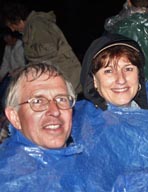 |
The Venue
This is not to say that the festival always runs like clockwork. “There are always eight or 10 things that go different than you expect,” said Nygren. Ruskey’s description is more metaphorical: “The train always wants to go off the track. Every day it wants to crash. Our job is to keep nudging it back on.
”‘It’s a very solemn time when the tent goes up.’
–Mike ‘Rug’ Ruskey, stage manager
Setting up the festival’s signature tent is the first challenge. It goes up differently every year. Sometimes it takes hours and hours. “Last year it went up so fast that I wondered what went wrong,” said Nygren. Of course, most concertgoers just see the tent up when they arrive, and they are usually oblivious to the other challenges the festival occasionally faces as well, which is just as the staff wants it to be. Few people know that a porta-potty suddenly burst into flames one evening after a concert, nor were many in the audience aware that the plane that flew over the field during the act that opened for Dwight Yoakam actually carried a desperately late Yoakam, who ultimately went on stage as scheduled.
Despite the uncertainties of running an outdoor festival in a remote corner of the country, no scheduled concert has ever been cancelled, even for inclement weather. (Loretta Lynn couldn’t appear as scheduled in 1995 because her husband was ill, but she arranged for her sister, Crystal Gale, to take her place – a switch that met with approval from the audience.) Concerts have proceeded before and after and even during rain, and audiences seem to have happy memories of huddling under tarps while consuming Brie and merlot. Many remember the “Guitars and Saxes” concert in 1999 as one in which the damp crowd was fashionably clad in trash bags. Nelson even remembers listening to one concert from inside a sleeping bag. “We sell a lot of sweatshirts and blankets on cold evenings,” she added, and “when there are no more sweatshirts and blankets, people want to buy the tablecloths.”
In addition to being able to handle whatever the weather hands them, the audience is known as discerning but open to new musical ideas. As if to prove this, concertgoers last year snapped up 95 percent of the 600 available season passes before the lineup was even announced. “I’ve often said to Dyno that I wish I could pack up the audience and take them with me on the road,” said Gary Sheldon, the mellow maestro who is in his ninth year conducting the orchestra concerts.
‘It’s great to be part of a group of 3,000 people celebrating music together.’
–Michael Welp, concert goer
Performers looking out from the stage have been equally impressed by what Ruskey calls the “little environments” that the audience members set up, with tablecloths over their coolers and candles on their “tables.” It’s an unusual aspect of this venue that people are allowed to bring in whole meals and even alcoholic beverages. Entertainers often are a little concerned about performing at fairs and festivals, says Ruskey, because festival crowds can get a little rowdy. He assures visiting artists that here in Sandpoint, “The worst fight you’re going to see is over who’s going to get up and get the next bottle of chardonnay.”
Another noteworthy aspect of the audience is that it stretches beyond the festival grounds proper. Hundreds of listeners take their picnics to Lakeview Park just west of Memorial Field. Others spread their blankets just outside the field’s perimeter fence, and still more listen from their boats anchored in the lake just offshore. Although these options don’t give listeners quite the magical feeling that comes from being on the festival grounds as the lines of twinkling lights come on along the tents at dusk, they do make the music available to people for whom the price of a ticket is difficult to come up with.
And then there are the residents in the neighborhood that surrounds Memorial Field, who get to hear every concert whether they want to or not, and whose streets are full of festival-goers and their cars on concert nights. Although neighborhood residents have had some issues with the festival in the past, says Wahl, there have been few problems in the last 10 years, since limits have been set on noise level (98 decibels), crowd size (3,500 on the field), and how late bands may play (11 p.m.). One family a half block away even donates use of their driveway as a premium parking space to be auctioned off at the festival’s annual fundraiser, and they wash the car while its owners are listening to the concert.
The artists
The field, the staff, the reputation, the audiences, the community – they all make the festival an appealing venue for performers even though it can’t provide many of the things that performers often ask for, such as real dressing rooms (the festival provides trailers at the field) or some of the lighting they would like. When Ruskey “advances” shows, discussing their contracts with performers, he tries to ensure that they know exactly what to expect.
But even with the “no surprises” policy, artists can arrive disgruntled after hours on the bus and months on the road, sometimes having been treated like prima donnas. Ruskey is considered the consummate babysitter of cranky performers, having handled admirably the singer who couldn’t remember his lyrics, the artist who wanted to be supplied with six pairs of white socks, the band members who were so angry at each other that they wanted to draw a line down the middle of their trailer, and the performer who didn’t want to go on at 8:30 (as his contract required) because he didn’t like the number eight.
With years of experience mounting shows both in Sandpoint and elsewhere, Ruskey also has a particular appreciation for performers who behave professionally. The Doobie Brothers and the Nitty Gritty Dirt Band, for example, are “ridiculously nice people unaffected negatively by this industry,” he said. But even working with such great guys can have its downside. The outgoing and generous Doobie Brothers arrived in Sandpoint three days early for their sold-out performance, and by the time of their show, they and their crew had promised complimentary tickets to 600 newfound friends. Ruskey shrugs and laughs when remembering that the crowd absorbed this huge number of extras without incident: “It’s a friendly town, and the Doobie Brothers are friendly folks.”
The board
Overseeing it all is a board that some members have served on for decades – board terms are indefinite. Each member does, however, complete a self-evaluation every year. “The questions are rather pointed,” said Sabella, one of those who has been around nearly since the beginning. It’s more fun now that the years of debt are behind them, but the board has a couple of other things to be happy about as well.
One is that the festival is now back up to three orchestra concerts each season, with one – the Family Concert – provided by the Spokane Youth Symphony, which is far less expensive than the unionized Spokane Symphony. Another development that has particularly pleased the board is the alternative it has found to the Schweitzer Institute. “When we realized we could not continue the institute, we chose to do something in the community,” said Nelson. Although it is not as obvious as the concerts in August, this education focus is just as much a part of the festival.
‘It’s a passion, something we love too much to let die.’
–Marilyn Sabella, board member
In its current incarnation, the education program brings musicians into all the fifth-grade classrooms in Bonner and Boundary counties, introducing students to the different musical instruments that they will have an opportunity to learn to play the following year. Every fifth-grader also receives three tickets to the festival’s grand finale concert. The approach seems to be working: Local school district staffs indicate that enrollment in music classes is strong and that the outreach program has a significant influence on students’ decisions to take music.
The festival also pays for repairs on damaged school instruments, and as its education budget has increased, it has been able to provide more new ones as well. Gifts have included some of the most expensive instruments, which public schools have a hard time fitting into their budgets: marimbas, pianos, drum sets. “The most satisfying thing I have ever done,” said Wahl, “is deliver instruments to schools.” Readers of the Bonner County Daily Bee will recall seeing a photo of Wahl in the local paper last fall with the high school band teacher, a couple of students, and a long sought-after (and very expensive) tuba. The dream is eventually to create a youth or community orchestra.
The future
Having found a “compromise that works,” the festival’s staff and directors say there are no plans to make the festival bigger, just better. The audience’s experience is enormously important to the staff and volunteers. That’s why there’s a red carpet and a glass of champagne for everyone (age 21 and up) who walks through the gates on opening night, and that’s why Nygren doubled the number of facilities in what is euphemistically called “the stool gardens” – he didn’t like the lines that people had to wait in. This year, the staff is particularly proud of their new sound system, which will enable them to move the stage back to provide extra room for the audience’s “little environments” and better sightlines as well.
‘I work with organizations that have budgets 10 times the size of the festival’s, and they don’t put out the quality that we do.’ –Dave Nygren, production manager
For those who have been at many other festivals, the unique aspects of this one are particularly evident. The community’s commitment to the festival year-round and the festival’s commitment to music education make it stand out even among better-known festivals around the country and the world. And while the venue is conducive to sophisticated setups for adults, it is also a comfortable one for families. It is a great way to introduce kids to all kinds of music, says Welp, who has taken his two daughters, now ages 6 and 8, to concerts for several years.
But perhaps the reason it is so special for the audience is that it is even more special for the people who put it on. As Wahl puts it, “Every year is a reunion at the festival.”
Ruskey likens it to an island – a little world unto itself in which a dedicated and professional group of staff and volunteers keep the boat sailing, never letting on that a performer is late or the tent went up backwards or a toilet caught on fire. In the haven they create, the audience can share their blankets and their chardonnay, set up their candles and tablecloths, don their garbage bags if it rains, and hear many kinds of music that they didn’t even know they enjoyed.
|
SOLD OUT: A rare feat |
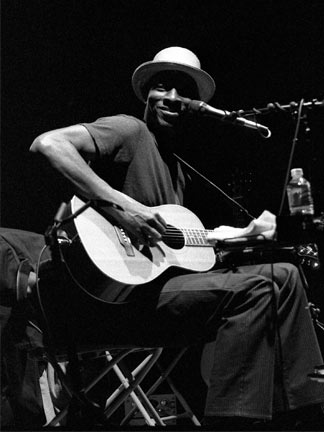
Kep Mo' sold out in 2002 |
Over the years, the Festival at Sandpoint has brought some tremendously popular acts to town. Who can forget Johnny Cash & June Carter and the Carter Family in 1993 or Warren Zevon in 2001? Still, as big as those names were, they weren’t one of the nine shows in 24 seasons that sold out. A few others came close.
Before 2001, the feat was a bit easier since capacity was only 2,500. In 2001 city officials decided to allow 1,000 more, so now 3,500 people can be on the grounds at Memorial Field, including ticket holders, musicians, production staff and volunteers, according to Executive Director Dyno Wahl.
“Last year, the only true sellout was Super Soul Sister Saturday with Ruthie Foster, Susan Tedeschi and Etta James,” she said. “Last year, all the shows would have been sold out had the old capacity been in effect.”
The only other sellouts since 2001 were Nitty Gritty Dirt Band and Keb’ Mo’ – both in 2002. A few shows were close to sellouts: David Gray and Nickel Creek, both in 2006; and Los Lobos and Bela Fleck, both in 2003.
Before capacity was increased, the bands that reached sellout status were: The Beach Boys (1995), Doobie Brothers (1997), The Pretenders (1998), Little Feat (1999), Manhattan Transfer (2000) and Nitty Gritty Dirt Band (1999) – the only act to sell out at both capacities.
–Billie Jean Plaster |
|
FESTIVAL-GOER'S GUIDE |
One local’s tips on how to do the festival right
Having a good time at the Festival at Sandpoint is easy. You can show up late, empty-handed, hungry and underdressed, and still enjoy yourself. However, with a little forethought and planning, you could have a truly epic time at the Festival, and isn’t that what it’s really all about?
First off, for the best seats, you have to get there early. My clan organizes an all-day sit-in, with the first shift showing up as early as 6 a.m., with replacements rolling in every couple of hours. When the gates open you’ll find yourself swept away in the stampede – get ready to run! Lay your blankets, unfold your sand chairs, and get your hot spot locked in for the evening’s entertainment. There is also a section farther back for taller chairs, and the bleachers make for good seating as well, but don’t forget your binoculars.
Now leave. Get your hand stamped, and take this hour to bring the rest of your articles of enjoyment together. Checklist: warm clothes, picnic basket, utensils (Important: Don’t forget silverware, glasses and a wine key), and your favorite beverages. (The festival allows spectators to bring alcoholic beverages, and that’s something worth toasting!) I usually choose red wine because it’s easy to keep at its desired temperature, though the most dedicated beer and cocktail lovers will bring along a cooler that doubles well as a table.
Though it’s great to come ready, Festival Street always has a wonderful selection of meals and desserts; there is a full bar as well.
It should be said that, though there is nothing better than sitting up front and dancing next to the stage, plenty of people still have a great time at the Festival without ever setting foot on the grounds. Just outside the gate is lovely Lakeview Park, where a whole other crowd gathers each night and enjoys the show – minus the ticket cost. You can barely spy the performers, but the music’s still terrific. Many people will also take their boats out onto the river and listen from the water. So if you find yourself without tickets, try a different location and revel in the coolest free concert you’ll ever attend. Or contact the Festival at Sandpoint to learn more about volunteering.
–Jenna Bowers |
|
The Festival Calendar |
The Festival at Sandpoint, the acclaimed outdoor music series, completes its first quarter century with a fantastic lineup for 2007. The eight dates fall over a two-week period from Aug. 2-12, truly the pinnacle of Sandpoint’s summer season. Buy a season pass – only 600 are sold – and don’t miss a show. Or snag one of 2,100 individual tickets by calling (208) 265-4554 or toll-free (888) 265-4554; or look up www.festivalat sandpoint.com. All shows at Memorial Field; gates open at 6 p.m. on Thursdays and Fridays and at 4:30 p.m. on Saturdays and Sundays.
Thursday, Aug. 2 at 7:30 p.m. The 25th annual season opens with “A Musical Reunion,” a pops concert featuring the Spokane Symphony Orchestra and favorite guest artists from the festival’s past, conducted by Maestro Gary Sheldon.
Friday, Aug. 3 at 7 p.m. That would be Phat Phriday I with singer-songwriter LeRoy Bell and His Only Friends, an acoustic soul artist opening for blues rocker Jonny Lang. The former instrumentalist prodigy just won a Grammy for his latest album, Turn Around. A 26-year-old who released his first album at age 15, Lang now stands as a mature creative force.
Saturday, Aug. 4 at 6 p.m. The first
Super Saturday brings back festival alumnus Lyle Lovett, who first performed here in 1993, as the headliner. The winner of four Grammy Awards, the singer-songwriter who bounds across genres is one of the most revered musicians of his time. Opening for him is Bearfoot, a young indie acoustic band of five from Alaska that plays bluegrass, Americana and roots music.
Sunday, Aug. 5 at 4:30 p.m. Round up the little ones and bring them down for the Family Concert, featuring the Spokane Youth Orchestra conducted by Verne Windham and Gary Sheldon. Fun kids’ activities, such as the Instrument Petting Zoo, precede the always-popular concert.
Thursday, Aug. 9 at 7:30 p.m. The second week of the festival starts off country with the five hard-playing Texans who make up Reckless Kelly opening for the Robert Earl Keen Band. Known as the King of the Texas Music Scene, Keen writes music that is best described as raw, down-to-earth alternative country. He pioneered the sound called “Texas Country.” Come early for complimentary microbrew tasting at 6 p.m.
Friday, Aug. 10 at 7 p.m. That would be Phat Phriday II, featuring main headliner Los Lonely Boys, three Texan brothers whose self-titled debut album was a stunning fusion of electric blues and Texas roots. 2004 Grammy Award winners, Los Lonely Boys followed up with Sacred, released in 2006. Opening for LLB is Jackie Greene, back by popular demand, after opening for David Gray in 2006. Another prodigy, Greene is a singer-songwriter and multi-instrumentalist who plays pop, folk, blues and country.
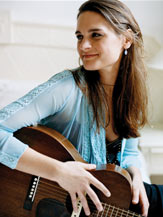 |
Saturday, Aug. 11 at 6 p.m. A homegrown Idahoan, Josh Ritter and his band opens for Madeleine Peyroux, a French-American singer for the second Super Saturday. Hailing from Moscow, Ritter, 29, is a guitar-toting singer-songwriter with an ever-growing fan base and four CDs under his belt. Singer-songwriter Peyroux, who has three CDs, is often compared to Billie Holliday. One reviewer says she “confidently walks the line where jazz, country and blues collide.”
Sunday, Aug. 12 at 6:30 p.m. Fireworks light up the Grand Finale concert featuring the Spokane Symphony Orchestra conducted by Maestro Sheldon performing pops and classical compositions with special guest violinist Mark O’Connor, a bright talent widely recognized as one of the most gifted contemporary composers in America, performing the entire second half. Come early for complimentary “Taste of the Stars” wine tasting at 4:30 p.m. |
|
Getting it down on paper, and other mediums |
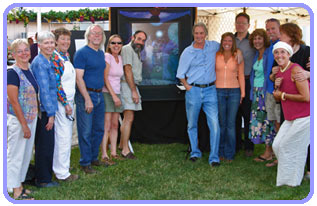
Past poster artists gathered around 2006 poster art and artist Dann Hall. From left are Gerri Harvill, Sue Graves, Bonnie Shields, Bill Klein, Ann Porter, Doug Jones, Hall, Amy Tessier, Ward Tollbom, Betty Billups, Dan SHook, Patricia Barkely and Gail Lyster. |
Artists create fabulous original artwork for season posters.
The Festival at Sandpoint is the soundtrack to our summers, a part of what makes Sandpoint, Sandpoint. And just as each year’s musical lineup is distinctive and varied, so is the design of each piece of art that has represented it.
Beginning with the first poster artist, Paula Youngstrom, talented local artists have been chosen by their peers to create their unique versions of the festival poster. Each year the previous festival poster artists gather to decide who should be the next to capture the magic that is the Festival at Sandpoint.
 |
A fortunate trend began in 1999 with Diana Schuppel’s poster. Her whimsical painting fetched a record bid of $3,800. Since then, with a few exceptions, the winning bid has been going up every year. The 2005 piece by Janeen A. Schissler broke the record at $7,250. Schuppel thinks that people are drawn to her piece, which depicts colorful insects looking through the fence at the Festival, because, quite simply: “It is happy, and people like to feel good. It was a joy for me to create, as it came at a time in my life of personal turmoil, and it became a focus for me, a way to be lifted away.”
Artists have used a multitude of varying mediums, from stained glass and found objects to tiles and quilts. 2001 Festival poster artist Dan Shook chose sculpture as his interpretation. He was the first and only artist so far to use this medium. His piece was also unique in that he sought assistance from others in his creation. Ted Bowers built a stand to hold the sculpture, and Dann Hall, the 2006 artist, took the photograph that became the poster. Shook said being chosen to contribute was “such a confirmation that I am a respected member of the artistic community.” He added: “It was profound and so inspirational, it really got my juices flowing. My cheeks hurt from so much smiling by the time it was all done.”
All of the artwork is donated, and all proceeds from the poster sales and auction of the original piece go to the festival. Posters are kept affordable for all, at $5 for an unsigned print and $10 for one signed by the artist. Five hundred are printed every year, though a few more have been made in the past for the most popular ones. They are still available, singly or as a complete set for $500, which includes a rare print from the first year. There are a few places around town to view the entire lineup: Bonner General Hospital, Sandpoint West Athletic Club, or at the Festival at Sandpoint headquarters at The Old Power House, where the posters can also be purchased.
Every year the original artwork is unveiled three weeks prior to the start of the concert series. As always, the community awaits the unveiling of what will undoubtedly become an iconic image of the Festival at Sandpoint, and of Sandpoint itself. The beloved series is inextricably linked with the depiction of the artist’s interpretation.
–Jenna Bowers
|
|
25th year artist Janene Grende: Bright style, whimsical inspirations |
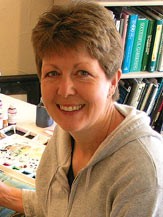 |
This year’s festival poster artist is painter Janene Grende. She branched out into creating vibrant silk paintings 10 years ago, and as her technical skills evolve, so does her passion for the challenging medium.
Local artists consider the invitation to create the poster art an honor, and Grende echoed that.
“I’m really thrilled,” she said. “I’m glad it came at this time in my career. If I had been chosen earlier, I might not have done the poster justice. I have learned a lot about painting with silk over the last 10 years, and I know what I need to do to make a piece that will translate well into a poster. It has to be bright, colorful and attractive.”
Those are attributes you can count on: To see Grende’s vibrant style check the cover art for this issue of Sandpoint Magazine, commissioned to go with this feature coverage.
The original poster artwork will be unveiled on July 12 at the Seasons at Sandpoint. “The original will be a silk painting with a North Idaho theme – the lake, animals, music, lots of dancing,” she said. “I want it to make people smile.” She mentioned among her inspirations previous poster artists Amy Tessier, Bonnie Shields and Diana Schuppel.
|
|
The music makers |
Over the first 24 years, more than 100 headline acts have taken the stage. A sample of those not mentioned elsewhere:
1987
Nicolette Larson • Doc Watson
1990
John McCutcheon
Michael Martin Murphey
1992
Wynton Marsalis • Tony Bennett • Jan & Dean
Emmy Lou Harris
1993
B.B. King • Lyle Lovett
Kathy Mattea
1994
Riders in the Sky • Robert Cray Band • The Temptations • Nanci Griffith • Maureen McGovern • Neville Brothers
1995
Bellamy Brothers • Natalie Cole
Alison Krauss & Union Station
1996
Lou Rawls • Neil Sedaka
Hal Ketchum • Kathy Mattea
1997
George Benson • Booker T. Jones • Blind Boys of Alabama
John Mayall • Martina McBride
1998
John Hiatt • Al Jarreau
Suzy Boggus • John Prine
1999
Judy Collins • Peter Frampton
Hal Ketchum
2000
America • Leftover Salmon
Laura Love
2001
Lee Ann Womack • Scruj MacDuhk • Branford Marsalis
2002
Asleep at the Wheel • David Lindley & Wally Ingram • Air Supply
2003
The Lettermen • Tower of Power • Karla Bonoff • Shawn Colvin • Bela Fleck • Jerry Jeff Walker • Los Lobos
2004
Lou Rawls • Jim Messina
Dierks Bentley • Delbert McClinton • Buddy Guy
2005
Ryan Adams • Ronnie Milsap
2006
Tanya Tucker • Los Straightjackets • Dick Dale
Jackie Greene • David Gray
|
|
The Festival, The Book |
|
Now you can read all about it. Spearheaded by Festival at Sandpoint board member Jim Walter, the festival has produced a full-color, anniversary coffee table book. It’s written and edited by Marlisa Keyes and profusely illustrated with photos of performers and large reproductions of festival posters. “It’s an honest account” of the event’s history, said Walter. At $19.95, get it at the festival office, the Sandpoint Visitor Center, online at www.FestivalatSandpoint.com, or on the field during the festival.
|
|
|

|
|